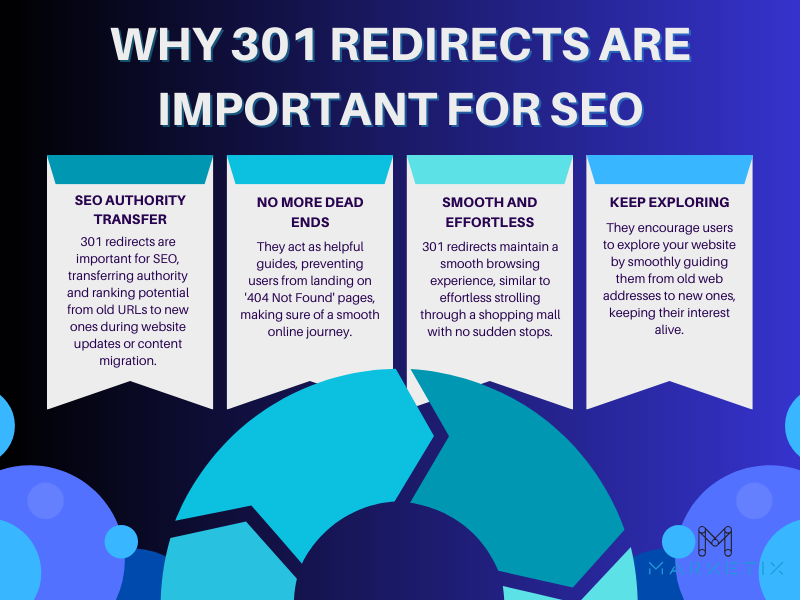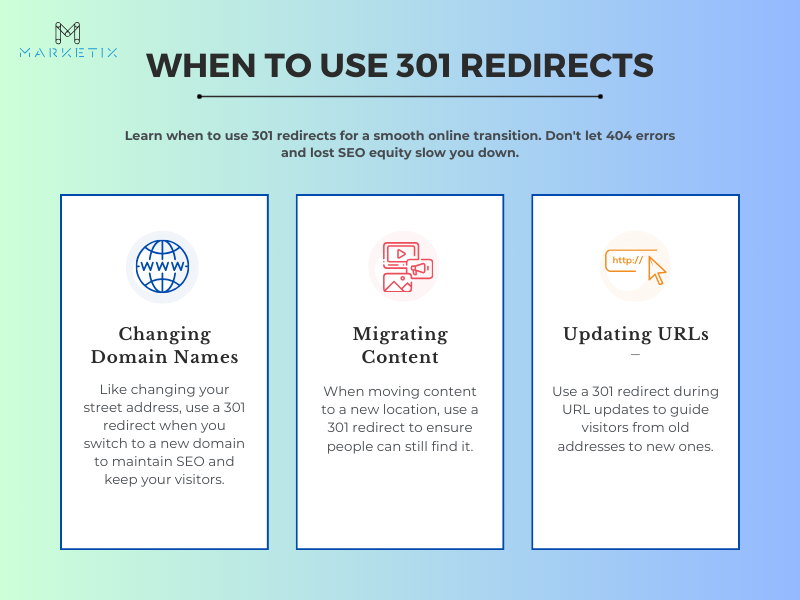- Home
- > The Marketix Blog
- > SEO
301 Redirects for SEO

Under the technical infrastructure of the internet lies a very important element for maintaining website navigation and rankings: the 301 redirect.
If you understand and know how to effectively implement 301 redirects, you hold a powerful tool for optimising your website's search engine performance and user experience.
Let's explore 301 redirects and see how they can impact your SEO and online presence.
What is A 301 Redirect?
A 301 redirect serves as the digital equivalent of a permanent change of address for a web page. Its name is derived from the HTTP response status code it utilises to execute this relocation seamlessly.
For instance, imagine you've shifted your webpage content from https://www.marketixdigital.com.au/blog/what-is-seo/ to https://www.marketixdigital.com.au/blog/seo/. That's where a 301 redirect steps in.
In simpler terms, it's akin to leaving a forwarding note at your old house after moving. This ensures that visitors looking for your old URL are seamlessly directed to the new one, maintaining uninterrupted web traffic flow.
Different Types of Redirects and Their Purposes
Think of redirects as internet traffic signs. They help people and search engines find their way. There are three main types: 301 Redirect, 302 Redirect, and Meta Refresh.
These may sound complex, but they're like road signs that say, 'We've moved,' 'Come back later,' or 'Here's something new.' Each type has its purpose, and knowing when to use them is important.
301 Redirect
When it comes to permanent changes in web page locations, the 301 redirect is the go-to tool. It's named after the HTTP status code it uses for the move.
Key Features:
- Permanent Move: This redirect signals a long-term relocation of a webpage.
- SEO Benefits: It helps maintain search engine rankings by transferring link equity to the new URL.
- Status Code: The HTTP status code 301 signifies that the move is permanent.
Purposes:
- Changing Domain Names: When switching domain names, a 301 redirect ensures seamless redirection of traffic to the new domain.
- Content Migration: During website restructuring or content updates, a 301 redirect will make sure that users are directed to the latest version of the content.
- URL Structure Updates: If URLs are modified for better organisation or SEO purposes, a 301 redirect ensures that old URLs still lead users to the relevant content.
302 Redirect (Temporary Redirect)
Unlike the 301 redirect, the 302 redirect indicates a temporary move of a webpage. It's particularly useful for short-term changes.
Key Features:
- Temporary Move: This redirect is ideal for situations where the move is temporary and the original URL will be reinstated.
- SEO Implications: Unlike the 301 redirect, a 302 redirect may not pass link equity to the new URL, potentially affecting search engine rankings. Search engines keep your old address in their records.
- Status Code: The HTTP status code 302 indicates that the move is temporary.
Purposes:
- Marketing Campaigns: Temporary redirects are commonly used in marketing campaigns to track specific user interactions or promotions.
- A/B Testing: Websites often use 302 redirects to test different versions of a webpage and compare user engagement metrics.
- Server Maintenance: During server maintenance or updates, a temporary redirect can inform users that the webpage is temporarily unavailable.
Meta Refresh
Meta refresh redirects are automatic refreshes executed using HTML meta tags. While not SEO-friendly, they serve specific purposes.
Key Features:
- Automatic Refresh: Meta refresh redirects automatically reload a webpage after a specified time interval.
- Not SEO-Friendly: Unlike server-side redirects, meta refresh redirects may not transfer link equity and can impact SEO.
- HTML Meta Tag: Meta refresh redirects are implemented using the <meta> tag in HTML.
Purposes:
- Simple URL Redirects: Meta refresh redirects are useful for simple URL redirections, such as redirecting users to a new webpage.
- Timed Announcements: Websites use meta refresh redirects to display timed announcements or alerts to users.
- Legacy Use: Although less common today due to SEO considerations, meta refresh redirects were previously used for URL redirections.
Why 301 Redirects Are Important for SEO?

Redirects are not just about keeping your website organised; they're important for maintaining your site's SEO health. Here's why:
Prevents Users from Landing on '404 Not Found' Pages
When a webpage is moved or deleted without implementing a redirect, users attempting to access the old URL may encounter a dreaded '404 Not Found' error.
It’s a frustrating experience that can lead to a negative perception of your website and drive users away.
301 redirect will make sure that visitors who attempt to access the old URL are seamlessly directed to the new location preventing them from encountering a dead end and maintaining a positive user experience.
Moreover, from an SEO perspective, '404 Not Found' errors can harm your website's search engine rankings. Search engines like Google interpret these errors as a sign of poor website maintenance and may penalise your website accordingly.
301 redirect implementation is like sending a signal to search engines that the webpage has permanently moved, preserving any existing search engine rankings and ensuring that your website continues to perform well in search results.
Maintains a Smooth Browsing Experience
Consistency and accessibility are key components of a positive browsing experience.
When users encounter broken links or outdated URLs, it disrupts their browsing flow and undermines their trust in your website.
301 redirects play an important role in maintaining a smooth browsing experience by seamlessly guiding users from old URLs to their new destinations.
Additionally, by proactively managing redirects, you demonstrate to users that you value their time and strive to provide them with a hassle-free browsing experience.
Encourages Users to Continue Exploring Your Website
Redirecting users from outdated or deleted web pages to relevant, up-to-date content encourages them to continue exploring your website.
Rather than hitting a dead end and abandoning their visit, users are presented with alternative options that keep them engaged and invested in your site.
Furthermore, by strategically implementing 301 redirects, you can guide users along desired pathways within your website, leading them to high-value pages or conversion opportunities.
When to Use 301 Redirects?

Knowing when to use a 301 redirect is like knowing when to use your GPS. Here are the everyday situations where these redirects become your online GPS:
Changing Domain Names
When you decide to change your website's domain name, implementing 301 redirects is a must to make sure a smooth transition for both users and search engines.
Redirecting old URLs to the corresponding pages on the new domain preserves your website's search engine rankings and prevents users from encountering broken links or '404 Not Found' errors.
Tip: We notify Google about the move to a new domain, and use Google Search Console. Submit a change of address request, which informs Google's algorithms that your website has permanently moved to a new domain.
Migrating Content
When migrating content from one URL to another within the same domain or to a new domain, 301 redirects are important for preserving the authority and relevance of the original content. Whether you're restructuring your website, consolidating pages, or updating URLs for improved SEO, implementing redirects will make sure that users and search engines are seamlessly guided to the new location of the content.
Additionally, when migrating content, it's important to conduct thorough testing to make sure that redirects are properly implemented and functioning as intended.
Regularly monitor your website's performance and address any issues that arise promptly to maintain a positive user experience and preserve your website's search engine rankings.
Updating URLs
As part of ongoing website maintenance and optimisation efforts, updating URLs may become necessary to improve site structure, keyword targeting, or user experience.
When updating URLs, it's important to implement 301 redirects from the old URLs to the new ones to ensure that any existing backlinks, search engine rankings, and user bookmarks are preserved.
Furthermore, when updating URLs, consider implementing best practices for URL structure, such as using descriptive keywords, avoiding unnecessary parameters, and maintaining consistency throughout your website. This not only improves the clarity and usability of your URLs but also enhances their relevance and visibility in search engine results.
How to Implement 301 Redirects?

Setting up 301 redirects may seem complicated, but it's an important skill for website management. These steps will guide you through the process:
Step 1: Know the Old and New Addresses
Before implementing 301 redirects, it's important to identify both the old and new URLs involved in the redirection process.
Example:
Old: https://marketixdigital.com.au/old/
New: https://marketixdigital.com.au/new/
Tip: If you plan to do it to multiple URLs, we recommend arranging them first using a spreadsheet.
Step 2: Choose How to Do It
To create 301 redirects, you'll need different methods based on your website's technology. Here are practical examples and easy-to-understand code snippets for each approach:
Using .htaccess
If your website runs on an Apache server, you can set up 301 redirects using an .htaccess file. Here's how:
Create or edit your .htaccess file.
Add these lines:
RewriteEngine On
RewriteRule ^old-url$ /new-url [R=301,L]
Replace "old-url" with the web address you want to redirect from and "new-url" with the new address you want to send users to. The [R=301,L] part tells the server that it's a permanent (301) redirect and stops processing other rules if this one matches.
Server-Side Scripting (PHP Example)
If your website uses PHP, you can make 301 redirects directly in your code. Here's a simple PHP example:
Create a new PHP file or edit an existing one.
Add these lines:
<?php
header("HTTP/1.1 301 Moved Permanently");
header("Location: /new-url");
?>
Replace "/new-url" with the actual web address you want users to go to. When someone visits a page with this code, they'll be automatically sent to the new address.
CMS Plugins
For those using platforms like WordPress, some plugins make setting up 301 redirects a breeze. Here's how it works with the "Redirection" plugin:
1. Install and activate the "Redirection" plugin on your WordPress website.
2. In your WordPress dashboard, go to "Tools" and select "Redirection."
3. Fill in the old URL in the "Source URL" field and the new URL in the "Target URL" field.
4. Choose "301 - Permanent" as the type of redirect you want.
5. Click "Add Redirect" to save your settings.
With this plugin, you can easily manage redirects without dealing with complicated code. It's a user-friendly solution, especially if you're not very tech-savvy.
Step 3: Set Up the Redirects
Once you've chosen the appropriate method for implementing 301 redirects, proceed to set up the redirects for each old URL. You need to make sure that the redirects are configured correctly to point users and search engines to the corresponding new URLs.
Step 4: Test Everything
Once you've set up 301 redirects, it's important to check that they're doing their job correctly.
You want to double-check that when someone clicks on an old web address, they're taken to the new one as intended. Here's how you can do that:
- Online Redirect Checkers: Some websites offer free tools to quickly check if your redirects are working correctly. You just paste the old web address, and these tools tell you if it's leading people to the new one without any problems. It's simple and doesn't require technical skills.
- Manual Testing: Sometimes, the best way to be sure a redirect is working is to test it yourself. Open your web browser, type in the old web address, and see if it takes you to the new place without any issues. Testing it manually helps you experience what your visitors will go through.
- Browser Extensions: If you use a web browser like Chrome, you can add extensions like 'Redirect Path.' These act like helpers while you're browsing your website. They show you the redirects as they happen and point out any errors. It's like having a co-pilot for your redirects.
Step 5: Keep an Eye on Things
Monitor the performance of your redirects regularly to ensure they continue to function correctly over time. Keep an eye out for any changes in traffic patterns or unexpected issues that may arise, and address them promptly to maintain a seamless browsing experience.
Step 6: Check Google Search Console
Finally, check Google Search Console to verify that Google has recognised and processed the redirects successfully.
Monitor any reported issues or warnings related to redirects and take necessary actions to resolve them to make sure optimal indexing and visibility of your website in Google's search results.
Important Consideration
When implementing 301 redirects, it's important to be vigilant for potential issues such as redirect loops and errors that can negatively impact user experience and SEO performance.
Identifying Redirect Loops
Redirect loops occur when two or more URLs redirect to each other in a continuous loop, causing browsers to get stuck in an endless redirection cycle.
To identify redirect loops, regularly audit your website's redirects using tools like Screaming Frog SEO Spider or Google Search Console.
Look for instances where URLs redirect back and forth between each other. Additionally, monitor user feedback and behaviour to identify any instances where visitors may be encountering redirection issues.
Resolving Redirect Loops and Errors
If you discover redirect loops or errors, take immediate steps to resolve them to prevent negative consequences for your website. Here are some strategies for addressing these issues:
- Review Redirect Chains: Check for any instances where multiple redirects are chained together unnecessarily. Simplify redirect chains to reduce the risk of errors and improve website performance.
- Update Redirect Rules: Review and update redirect rules as needed to ensure that they accurately reflect the intended redirection paths. Eliminate any conflicting or redundant rules that may contribute to redirect loops.
- Test Redirects: After making changes to redirect rules, thoroughly test the redirects to confirm that they are functioning correctly and are not causing any unintended issues. Use tools like online redirect checkers and manual testing to verify the correctness of redirects.
- Monitor Performance: Continuously monitor your website's performance and user feedback to identify any recurring issues with redirects. Address any reported problems promptly to maintain a positive user experience and preserve your website's SEO performance.
By actively monitoring for redirect loops and errors and promptly addressing any issues that arise, you can ensure that your website maintains smooth navigation and optimal SEO performance for users and search engines alike.
Final Thoughts
As a premier Sydney SEO and Google Ads Management Agency, Marketix Digital recognises the significance of these redirects in driving results for businesses of all sizes across Australia.
By utilising 301 redirects strategically, businesses can ensure seamless transitions during website restructuring, domain name changes, or URL updates, preserving search engine rankings and user experience.
At Marketix Digital, we focus solely on SEO, SEM, PPC, and Google Ads to deliver substantial results for our clients.
Our expertise and dedication empower businesses to achieve more conversions, revenue, and growth through effective search engine marketing strategies.

Free Download SEO Book
Download our 24-page SEO book to learn:
- How SEO Really Works
- How to Rank #1
- Content & SEO
- Choosing an SEO Agency
Thank you!
You have successfully joined our subscriber list.






